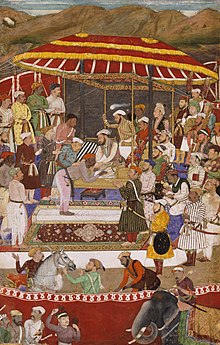Mughal conquest of Mewar
| Mughal conquest of Mewar (1615) | |||||||
|---|---|---|---|---|---|---|---|
| Part of Mughal conquests | |||||||
 Painting of Amar Singh I to Shah Jahan | |||||||
| |||||||
| Belligerents | |||||||
|
|
| ||||||
| Commanders and leaders | |||||||
|
|
| ||||||
The Mughal conquest of Mewar was a military campaign led by Shah Jahan under the command of Emperor Jahangir in 1615.[3][page needed] After a year of attrition warfare, Rana Amar Singh I surrendered conditionally to the Mughal forces.[4][page needed]
Background
[edit]Amar Singh I, who succeeded Maharana Pratap, continued to contradict the Mughals. Following initial strikes, the Mughals took control of the plains of Mewar, forcing Amar Singh and his father into hiding. When Jahangir ascended to the throne, he launched a series of assaults against Amar Singh. Jahangir may have blamed himself for his failure to subdue the Sisodia Dynasty, as he had entrusted this task to Amar Singh twice while under Akbar's rule. Thus, Jahangir was determined to defeat Amar Singh, so he sent Prince Parviz to subdue him, leading to the Battle of Dewair. However, Parviz had to halt the campaign due to Khusrau Mirza's rebellion.[5][page needed] Despite Jahangir's appointment of Parviz, the battle was mainly commanded by Jahangir's brother-in-law, Asaf Khan, with Parviz serving as a symbolic figurehead.[6][page needed]
After his attempt was unsuccessful, Jahangir sent Mahabat Khan, Abdullah Khan, and Prince Khurram in succession. The prolonged conflict depleted Amar Singh's resources, and he eventually prepared to submit.[7][page needed]
Aftermath
[edit]In 1615, Amar Singh submitted to the Mughals. The terms of submission were designed to satisfy both sides. Due to his advanced age, Amar Singh was not required to personally attend the Mughal court, and he was granted Mewar, including the city of Chittor, as a watan jagir (territory granted as a hereditary estate). Amar Singh's successor, Karan Singh, received a rank of 5,000. Meanwhile, the Mughals safeguarded their interests by prohibiting the fortification of Mewar.[8][page needed]
Peace treaty
[edit]Following the loss of soldiers and finances caused by battles against the Mughals, Amar Singh deemed it wise to initiate negotiations with them. In 1615, he entered a treaty with Shah Jahan, who negotiated on behalf of Jahangir. Amar Singh received counsel from his advisors, including his grandmother, Jaiwanta Bai.[citation needed]
According to the treaty, the ruler of Mewar was not obligated to personally appear at the Mughal court; instead, a relative of the Rana would represent him and serve the Mughal Emperor.[9][page needed] Additionally, the agreement stipulated that the Ranas of Mewar were prohibited from forming matrimonial relations with the Mughals.[10] Mewar was also required to maintain a contingent of 1,500 horsemen to serve Mughal.[11][page needed]
In recognition of his submission, the Rana was granted a Mughal rank of 5,000 zat (infantry soldiers) and 5,000 sowar (cavalry soldiers).[12][page needed]
Later, when Amar Singh I visited Jahangir at Ajmer, he received a welcome from the Mughal Emperor, and the territories surrounding Chittor, including the Chittor Fort, were returned to Mewar as a gesture of goodwill.[13]
References
[edit]- ^ Welch, Stuart Cary (1987). The Emperors' Album: Images of Mughal India. Metropolitan Museum of Art. ISBN 978-0-87099-499-9.
Early in the year, Prince Khurram (now subadar, or of Malwa with a mansob of 13,000 zat and ads 13,000 mem against Mewar After terrible battles, Rana Amar Singh surrenders Mewar's independence
- ^ Edwardes, Stephen Meredyth; Garrett, Herbert Leonard Offley (1995). Mughal Rule in India. Atlantic Publishers & Dist. p. 61. ISBN 978-81-7156-551-1.
There was the war with Mewar a legacy of earlier days which was finally ended in 1614 by the surrender of Rana Amar Singh and his son Karan to the imperial army under Prince Khurram.
- ^ Jahangir, Emperor of Hindustan; Thackston, W. M. (Wheeler McIntosh) (1999). The Jahangirnama : memoirs of Jahangir, Emperor of India. Smithsonian Libraries. Washington, D. C. : Freer Gallery of Art, Arthur M. Sackler Gallery, Smithsonian Institution ; New York : Oxford University Press. ISBN 978-0-19-512718-8.
- ^ Asher, Catherine Blanshard (1992-09-24). Architecture of Mughal India. Cambridge University Press. ISBN 978-0-521-26728-1.
- ^ Eraly, Abraham (2007-09-17). Emperors Of The Peacock Throne: The Saga of the Great Moghuls. Penguin Books Limited. ISBN 978-93-5118-093-7.
- ^ Jahangir, Emperor of Hindustan; Thackston, W. M. (Wheeler McIntosh) (1999). The Jahangirnama : memoirs of Jahangir, Emperor of India. Smithsonian Libraries. Washington, D. C. : Freer Gallery of Art, Arthur M. Sackler Gallery, Smithsonian Institution ; New York : Oxford University Press. ISBN 978-0-19-512718-8.
- ^ Sharma, Sri Ram (1971). Maharana Raj Singh and His Times. Motilal Banarsidass Publ. ISBN 978-81-208-2398-3.
- ^ Eraly, Abraham (2007-09-17). Emperors Of The Peacock Throne: The Saga of the Great Moghuls. Penguin Books Limited. ISBN 978-93-5118-093-7.
- ^ Satish, Chandra (2006). Medical India:From Sultanate to Mughals(1206-1506), vol. 2 (2nd Volume ed.). Har-Anand Publications. ISBN 8124112681.
- ^ "India - Mughal-Mewar Conflict, Niẓām Shāhīs, Marathas, Mahābat Khan Rebellion | Britannica". www.britannica.com. Retrieved 2023-06-09.
- ^ Kinra, Rajeev (2015-09-22). Writing Self, Writing Empire: Chandar Bhan Brahman and the Cultural World of the Indo-Persian State Secretary. Univ of California Press. ISBN 978-0-520-96168-5.
- ^ Chandra, Satish (1997). Medieval India: Delhi Sultanat, 1206-1526. Har-Anand Publications. ISBN 978-81-241-0522-1.
- ^ "India - Mughal-Mewar Conflict, Niẓām Shāhīs, Marathas, Mahābat Khan Rebellion | Britannica". www.britannica.com. Retrieved 2023-06-10.
